South African Diaries: Trip to the Drakensberg
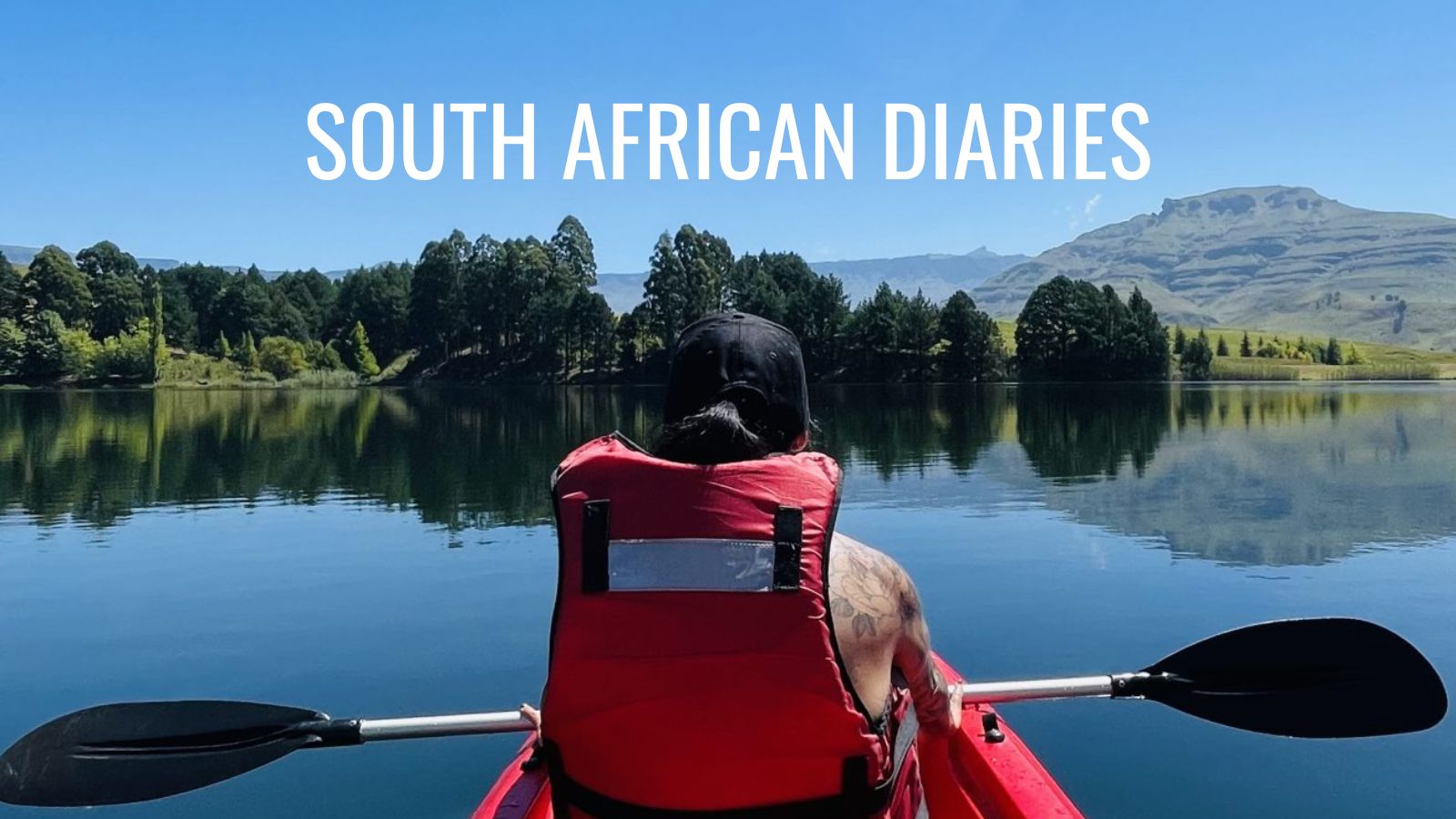
This is my sixth time visiting South Africa, all because I am lucky enough to be married to a South African guy. My very first trip to this amazing country was, in fact, for our wedding, a few years ago. Whenever I am in SA, I try to check out a new part of the country. This time, we were down for a month, and it was all about spending quality time with the family in Johannesburg, also partly due to my remote work. However, we had some interesting weekend trips lined up with the family, starting with my first time to the stunning Drakensberg Mountains. My husband has been going on about taking me to his favourite spot in the country for very long time, so we finally made it happen.
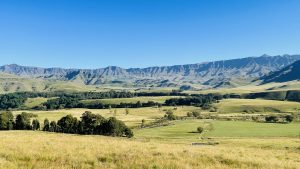
The plan was to leave early on a Friday morning following the N3 highway south, passing through the picturesque landscapes of the Free State and KwaZulu-Natal provinces, until our destination. There were some conflicting opinions about the travel time. Some believed it would take only 4 hours, but Google was telling us 7 hours – a long trip ahead of us indeed. I don’t drive, so the plan was for my husband and his dad to take turns behind the wheel. We had packed shorts, hats, sunglasses, swimming suits, and trainers, as the place we were staying promised few outdoor activities. We left Joburg around 8:40, with a mild temperature of 21 degrees Celsius. We had a heavy storm the night before, so the fresh air was a relief from the high temperatures we had been experiencing since our arrival in the country.
Even though it was the start of the weekend, there were not many cars on our side of the highway. On the opposite side, however, there was a steady stream of trucks and lorries making their way to Joburg. A reminder of the incessant activity of the city, contrasting with the tranquillity of the countryside. As we drove along the highway, strips of greenery and colourful blooms dotted the otherwise dry landscape, showing how plants can adapt to different weather conditions. Among these flowers, vibrant cosmos bloomed in shades of pink, orange, and white, adding a splash of colour to the scenery. Above our heads, a flight of swallows glided through the air above fields of corn –”mielies” how they call it here – that stretched alongside the road.
It was after 10am when we entered the Free State. This part of the country has played a significant role in shaping the cultural and political landscape of South Africa. In fact, it was here that various events took place, such as the struggles of the indigenous San and Khoi people, the arrival of Europeans, and the battles between the Boers (descendants of Dutch settlers) and the British. In more recent history, the Free State has been a symbol of resistance during the apartheid era, a key centre of activism, see the historic Women’s March of 1956, to protest the discriminatory pass laws. We passed small shacks on the side of the road, that together with the air filled with the smell of nearby farms, were the symbols of rural life.
Our first stop was at the Harrismith service station, around 11:30 am, after three hours on the road. We needed a break for toilets, fuel, and a quick bite to eat. We found a restaurant with outdoor seating on their terrace, opting for a shady spot to escape the strong midday sun. Despite the temperature reaching 28 degrees Celsius, a gentle breeze offered some relief from the heat. After an hour of relaxation, we were ready to hit the road again. As we resumed our journey, the Harrismith mountains emerged in the distance under the cloudless sky, predicting the landscapes that awaited us ahead.
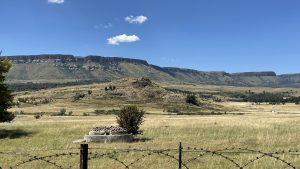
During the car ride, without data or Wi-Fi, we talked about various things about South Africa, from politics to the real estate market, animals, economy, and of course, food. We were talking about the Tugela River, which starts in the Drakensberg Mountains and flows to the Indian Ocean, when we noticed children crossing the highway returning from school. This reminded us of the stories we have heard about Zimbabwean migrants trying to cross into South Africa. Some of them face a tough journey through wild and dangerous areas, with risks from wild animals and criminals. Those who make it to the country, find temporary work in the cities to support their families back home, due to the terrible economic conditions in Zimbabwe. There are many undocumented migrants in South Africa, but with the country prepares for elections, border security measures are being tightened. Reflecting on this, being a migrant in a foreigner country myself, I couldn’t help but feel a sense of gratitude for my privileged life in comparison. While I am able to travel freely and enjoy the comforts of a home and job, many others risks their lives, hoping of a better existence elsewhere. It also made me thinking how for thousands of years, humans have drawn lines on maps and claimed ownership of land, even though it was originally meant for all to roam and live freely without boundaries or limits.
As we continued our journey, the road stretched out between weaver bird nests and tall aloe plants, leaving behind the dry landscape. On the side of the road, we passed forests of pine and eucalyptus stood tall as we entered the KwaZulu-Natal province. Driving through Zulu land opened the conversation about the situation and culture of the Zulu people. They are one of the largest ethnic groups in South Africa, with an estimated population of over 11 million. Their history has seen the rise of the Zulu Kingdom under the leadership of King Shaka in the early 19th century. Despite conflicts with European, including the Anglo-Zulu War, the Zulu people have managed to preserve their cultural identity. However, many Zulu communities still struggle with progress. They once lived in huts, but now many have begun to build houses, yet basic services like running water and sewage systems are still missing in some areas. Some of these houses has cone-shaped roofs, reminiscent of the traditional huts, as a reminder of their cultural heritage.
The final part of the journey led us through beautiful farmlands dotted with streams and sprinklers. The scenery reminded me of the English countryside in Somerset and at times of the Scottish Highlands. Ironically, we were heading towards a resort called Castleburn because the mountain, Garden Castle, which looms over the property, resembles the ruin of a Scottish castle and the word “burn,” as we discovered later, in Scotland refers to a small stream. It was 4:30 pm when we finally arrived at our destination, after an 8-hour journey. A flock of sheep and majestic pine trees welcomed us at Castleburn.

The reception area was located above a beautiful dam. A girl here gave us with some tips for the following day’s activities and mentioned the wildlife we might encounter, including elands, jackals, wild cats, servals, and snakes. Our accommodation consisted of a kitchen and living area, and 3 bedrooms on two floors, however we all decided to stay on the ground floor. The highlight of the unit was the patio, offering a stunning view of the tranquil dams filled with trout. Pin oaks towered over pretty houses with thatched roofs, resembling something out of a hobbit’s tale. Once unpacked, we settled outside with a refreshing G&T, enjoying the serene atmosphere by the water. Frogs serenaded us with their concert as we planned the activities for the following day.
The next morning, the plan was to get up early and hike one of the trails recommended by the reception. However, the overcast sky hid the mountains from view. So, we waited for the sun to make an appearance as forecasted and went out just before 9 AM. Despite the early hour, the warmth of the day was already intense. As we made our way, conversation turned to some disagreement about, as usual, the starting point of the trail. In the end, we decided to follow the water’s edge as shown on the map. As we walked on the morning grass, we felt the freshness of the dewy stems on our bare legs. We were walking along the lake, admiring at the same time, the pretty Egyptian geese floating on the water, when we came across a gentleman with a slight Scottish accent walking his two dogs in the opposite direction. The gentleman turned out to be the farm owner. He told us his story, of how he had moved from Scotland, his native land, and settled in Johannesburg, then bought and turned this piece of land into a paradise for hikers and animals, and the origins of the name Castleburn. He also informed that a group of elands was not far from there and encouraged us to try and get closer to see them. We resumed our walk, noticing signs of moles activity nearby. The ground had a reddish shade, like what I had observed during our drive to the area. Eventually, we spotted the group of elands about a kilometre away. We cautiously tried to get closer, making sure not to make too much noise and scared them. However, while trying to retrieve our phones, from our bags, to capture the moment, the rustling of a food bag caught their attention: they observed our movements with a curiosity, remaining as still as a painting. Elands are known for their massive size and the cool, twisty horns. Although they spend their days grazing on grass, they are super important for the ecosystem, helping to keep things balanced by munching on vegetation and providing meals for other animals.
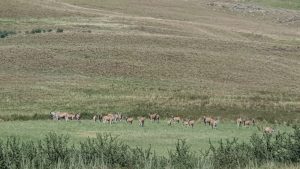
That was the only animal sighting during the walk, which continued peacefully, apart from the annoying flies that had accompanied us throughout the route. During the walk, we stopped more than once to admire the Drakensberg mountains. Drakensberg, Afrikaans for “Dragon Mountains”, is a massive mountain range in South Africa. It stretches over 1,000 kilometres and is known for its stunning natural beauty and its rich biodiversity. The range is characterized by towering peaks, deep valleys, and waterfalls, and here it is possible to see ancient rock art sites left behind by the San people, Bushmen, thousands of years ago. With its diverse flora and fauna, fascinating cultural heritage, is now part of UNESCO. We could see some of its prominent peaks include Rhino Peak, Giant’s Castle, Hodgson’s Peaks, and Mount Lebanon on the border with Lesotho.
In the afternoon, after our walk, we decided to rent a kayak and go on the nearby lake. The water was incredibly calm, with only the sweet sound of birdsong. We paddled through the reeds, and among them, we managed to see the eland we had spotted in the morning, peacefully grazing in the same green spot. After an hour of kayaking on the calm water, the sun became increasingly hot, so we decided to return to shore and cool off in the pool before lunch. The rest of the day passed in relaxation, with short walks, quizzes, dinner, and a game of Rummikub.
Before bed, we stepped outside to gaze at the stars It was incredibly beautiful, such a clear sky. One of the most beautiful things to see in South Africa are the sunsets and starry skies. The Milky Way stretched across the sky, with its millions of stars. We could easily see the Southern Cross and Orion’s Belt. The visibility was even clearer with the approaching new moon.
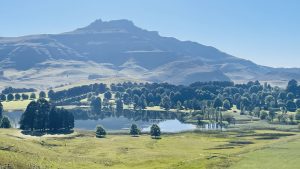
On Sunday, our last day, we got up early around 6:30 AM and set out on a different trail, opting for a longer route this time. The morning air was a bit chilly. As we ventured out, we noticed that the elands had come closer to our unit. It seemed that one of the youngest antelopes had become separated from the rest of the group. They were nervous, pacing back and forth in search of their companions. After a while, a few older elands emerged to guide them back to the safety of the group. Despite episodes like this, life for eland in the mountains proceeds fairly peacefully; here they can graze without worrying about predators or poachers.We crossed the familiar field from the day before, the fresh grass brushing against our legs again. This time, the field was adorned with hundreds of sparkling spiderwebs, the work of the morning dew. Mist hovered over the water, creating an ethereal atmosphere, while dragonflies drank from the condensation on the grass. Nature’s ingenuity is a magical sight. Around 8:15, we reached the highest point. The sun was already shining intensely. Up there, we felt incredibly at peace, as the only sounds were the gentle buzz of insects and the distant echo of birds in the valley below. Along the trail, we noticed signs of the wildlife that inhabits these places: wildcats, jackals, deer, and even snakes. We made sure to walk carefully, especially wanting to avoid the possibility of encountering the Puff Adder, famous for its mimicking abilities and potent venom.

There is something truly magical about the quiet solitude of a hike. With nothing but the sound of nature surrounding you it’s the perfect setting for a moment of introspection and inspiration. As your feet carry you along a trail, your mind is free to wander and explore new ideas. Moments like these remind us of the deep connection between humans and nature. It is likely that the early people who inhabited those places had a profound connection with the surrounding environment and experienced similar sensations.
As the sun grew stronger, we began the descent back to our accommodation. By 9 am, we were back at our base, with the whole day still ahead of us and our next destination: the Drakensberg Gardens, located at the foot of the majestic mountain range. We retraced our route from two days earlier and followed the path downhill. Once down, we turned left and continued for about 15 minutes until we reached the Gooderson Drakensberg Gardens, another, more luxurious resort, in the heart of the Drakensberg Mountains. We made our way up to the restaurant overlooking the golf course and sat outside, seeking refuge from the intense midday sun under the shade of an umbrella. Before us, Rhino Peak stood majestically tall at approximately 3,050 meters. In other points of the resort, it could also be possible to catch glimpsed of Garden Castle and Cathedral Peak in the distance. These ancient mountains have witnessed millennia of human activity. The earliest people to inhabit the area for thousands of years were the San, also known as Bushmen. They left a remarkable cultural mark through their rock paintings, found in numerous mountain caves. Their art offers a glimpse into their daily life, spiritual beliefs, and connections with nature. Most of the San paintings are not accessible to the public. A shame because I would have liked to visit the caves and see these ancient works of art in person. The Drakensberg mountains played a significant role in struggles for land and power during colonial expansion in Southern Africa. European settlers, particularly the Boers and later the British, came to this region, seeking fertile land for farming and grazing. This period of colonization led to conflicts with indigenous peoples, including the San and later other groups. The mountains also provided a crucial backdrop for famous battles, where British forces fought with Zulu warriors. In the early 20th century, the Drakensberg mountains became a focal point for conservation efforts, thanks to their ecological importance and unique biodiversity. We spent a couple of hours here, enjoying the scenery and watching a group of German tourists play golf.
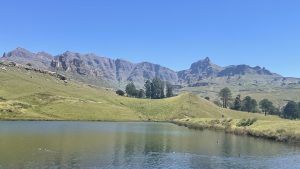
As we made our way back to our unit, we found ourselves already planning our next visit. Next time, we are aiming to explore the other side of the Drakensberg, specifically Cathedral Peak. The idea to hike these beautiful mountains and perhaps even camping out, as my husband, who’s been there before, highly recommends, it’s so excited. This trip was my first taste of what the Drakensberg has to offer, and next time I return, I’ll come armed with a deeper understanding of the landscape, history, geography, and morphology of the region.
On this journey through the Drakensberg Mountains, I had the privilege to explore not only breathtaking landscapes but also to learn more about its rich history. Every step along the trails represented a moment of deep connection with nature and inner reflection. Watching the stars in the African sky and sharing stories around the fire were moments that will stay with me forever, confirming my bond with this extraordinary land. I am grateful once again for the opportunity given to get closer to these places and to appreciate the diversity of South Africa. The road trip and walks on the these mountains will remain a precious treasure in my life, ontinuing to inspire me a profound gratitude for the world around us.
Written by Stella D’Angelo



